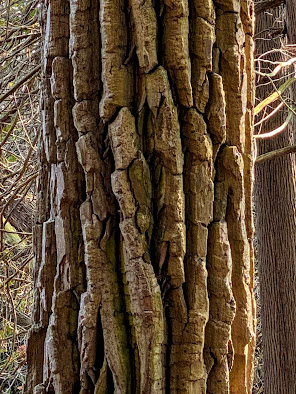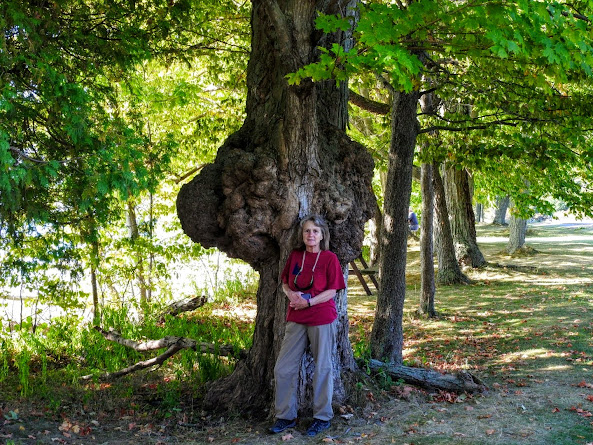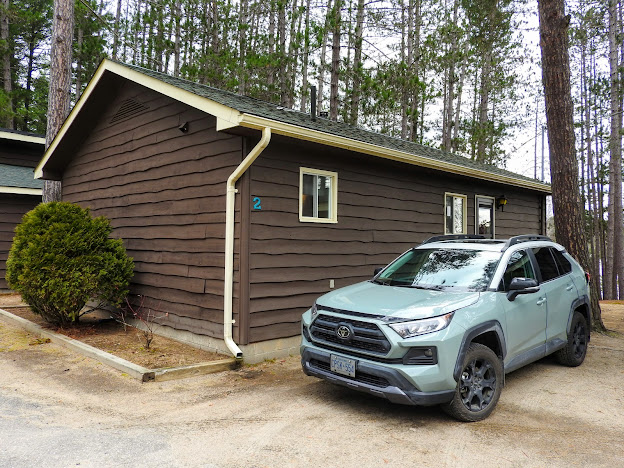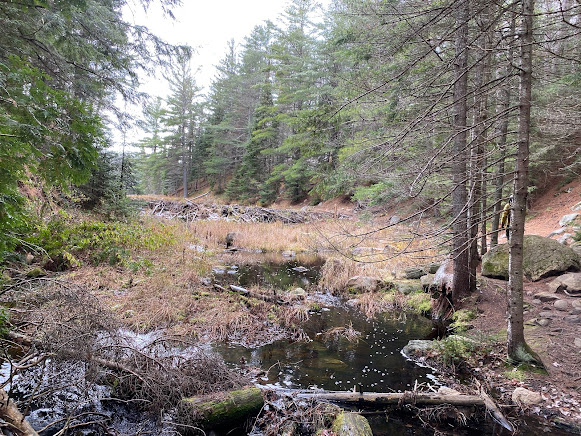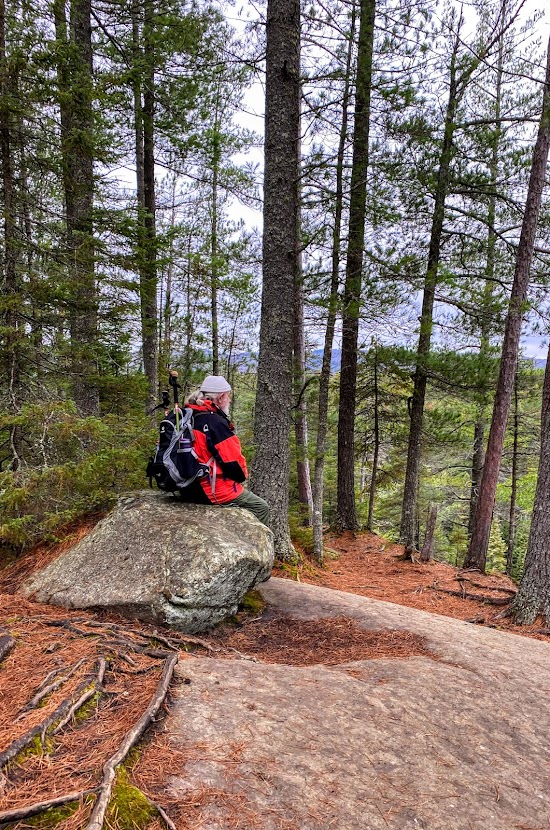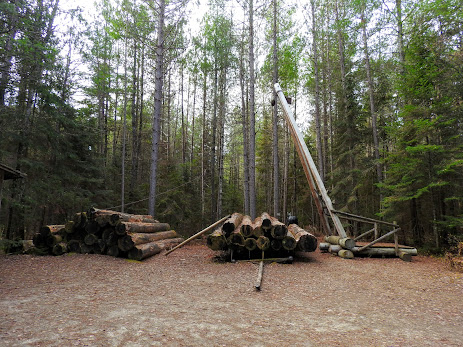... During a Pandemic, Includes a Couple of Route Deviations and We Drive Two Different Rigs
_______________________________________
Click any of these links if you are interested in additional information.
This darned Covid-19 pandemic has had a dramatic effect on how many of us have been able to or are willing to travel at this time. We returned from a 58 day stay on Cozumel Island in Mexico in March and haven't really travelled anywhere, in any serious fashion since then. Initially, while at home, we were social distancing and adhering to all the new rules and regulations that were being implemented by our various government agencies. Eventually though, like many of our friends and neighbours, we began to tackle home renovation and landscaping projects, just to stay busy. All those projects have now been completed for this year ... so, what to do now?
Throughout that time, LOAF was parked at a nearby indoor storage facility and we reluctantly had no intention of taking our TC rig out this year. Earlier in the year, we did have plans for this travel season ... in the spring, we'd head to Canada's east coast and hunt for icebergs - but, that was cancelled due to restrictions placed on travellers from other provinces venturing there (called the East Coast Bubble); much the same with our alternate plan to head west and spend time visiting the Rocky Mountain Parks.
We've been following developments in Cozumel in order to understand the impact the virus may have on our annual diving/snorkelling trip there during the winter months. There now appears to be a low probability of us travelling there at all this winter, due to health risks associated with airline flights and the Canadian government's announcement that borders may become closed once again if there are future waves of the virus.
We've come to the conclusion, (not being 'winter folks'), that we needed to escape, if only for a short trip. The unpleasant scenario of spending winter months cooped-up for long periods of time, was beginning to stress us out. Soooo ... LOAF came out of storage, we purchased a new tandem inflatable kayak, LOAF's energy output has been upgraded - we've nearly tripled our solar capability (now 255 watts of panel, a 3000 watt inverter), we can power all plugs (12/120 volts) and our microwave (just not a/c), we are able to truly be off-grid, we're packed with paddling, cycling and hiking gear, PEC county wines and an assortment of supplies. We've been fortunate to get some reservation campsite bookings but don't really have a solid itinerary in mind ... only that we'll wander around Ontario for a month or so and search out the Autumn colours.
We had lots of big plans, but in the end ...
We stayed at a couple of Provincial Park campgrounds, a couple of hotel rooms, an air b&b and a cabin ... our adventures were mostly soft and even softer. We got away for 16 nights in total (over 4 separate short trips). We did enjoy easy to moderate hikes on several trails but unfortunately, the late fall season, and the cold-rainy-snowy weather that we encountered, kept our new inflatable kayak hidden away and stored unused as cargo. Oh! , I almost forgot ... one of us had an injury (during our second last day) that forced us to cancel the remainder of our planned hikes.
A hotel stay for our 48th 'together' Anniversary ... CHEERS!
_________________________________________
Our route map and photography tells the story of this adventure.
Our ROUTE
_________________________
ALGONQUIN PROVINCIAL PARK
Algonquin Provincial Park is a provincial park located between Georgian Bay and the Ottawa River in Ontario, Canada, mostly within the Unorganized South Part of Nipissing District. Established in 1893, " it is the oldest provincial park in Canada". Additions since its creation have increased the park to its current size of about 7,653 square kilometres. The Park is also a National Historic Site of Canada.
Lake of Two Rivers Campground
Site 203
Even though my family had camped at several different campgrounds in Algonquin during my teen years and I had subsequently spent 4 seasons employed as a Canoe Ranger there, I had never actually camped at Lake of Two Rivers.
There is a mixture of full and no service sites. We chose a no-service site which, when compared to others is larger, usually well-treed and fairly private. The Park appears to be operating with a skeleton staff and some services have been reduced or even eliminated. Reservations are not being verified by campground attendants, permits are not being handed out for campsites or vehicles, some sites are not being used, firewood is only available at Mew Lk CG.
These old trees have had nails and screws stabbed into them, they've been scarred by countless axe cuts from negligent campers harvesting their bark for campfire kindling; and yet they persevere. Ironically, back about 15 feet from these two is a stand of spruce; laden with small, dry and dead lower branches that are ideal as fire-starter.
Can't do much ... we're walking when it's not pouring rain and sitting around a campfire when the rain stops, hence the lack of photos.
_________________________
PRESQU'ILE PROVINCIAL PARK
Presqu'ile Provincial Park is a park in southeastern Northumberland County on the north shore of Lake Ontario near the town of Brighton in Ontario, Canada. The name of the park is the French word for peninsula, or literally "almost island", and was believed to be named by Samuel De Champlain on his second expedition. The peninsula was formed when a limestone island was connected to the mainland by a sand spit; this kind of formation is referred to as a tombolo.
Lakeshore Campground
From our home in Wellington, it's about a 45 minute drive to this park. We've never been here, but we'll certainly return. I imagine it would be quite busy during the summer months but spring and fall would be an attractive time to come.
Lakeshore is a shore power 'free' campground. With our recently upgraded solar system we're now able to dry camp* effectively; it's like boondocking but without the solitude. We're in here with mostly just tenters so the sites are smallish but private; it's a quiet area, no generators ... cool evenings means folks bury into their sleeping bags early. We're enjoying some great Fall weather in this part of Ontario ... cool nights and sunny days!
*Dry camping is another term used to describe boondocking, but there is a slight distinction. While boondocking is camping without any hookups 'outside developed campgrounds', dry camping is simply camping without any hookups. The distinction is dry camping can take place at a developed campground.
Nothings changed!
In the early '70's, one of my duties as an
Algonquin Park Canoe Ranger was to collect garbage from interior backcountry campsites.
Now, 45 years later and ironically, I find myself doing much the same because ... '
things really haven't changed that much' ... campers still don't seem to care! This pile was collected at site 244 in Presqu'ile in about 20 minutes from an area in the rear of our campsite about 30 feet back into the surrounding forest ... mostly plastic bags, some glass, one shattered beer bottle, a golf ball?, several plastic and metal containers. And .... I'm not getting paid to do this now!
The weather was perfect for campfire cooking during our stay and we had several great meals; but this one was a standout!. There really is nothing better than campfire cooking ... just build-up a small pile of hardwood coals, add some local corn on the cob done Mexican style (with lime and pepper) and a bocconcini salad side using all local and fresh ingredients.
There's a cycling path that follows the Lake Ontario shoreline and the park's interior roadways. It's easy to do 10 kms without entering any of the campgrounds and mostly riding a designated cycling lane. Several hiking trails range from 0.3 to 4.8 kms; they're all easy (on the knees). We travelled the complete cycling path and hiked the Owen Point, Marsh Boardwalk, Jobes' Woods and Newcastle Trails. Click here for a map and descriptions of all trails.
The park's wetlands are one of the larger wetlands along the north shore of Lake Ontario, and are noteworthy for the many sand ridges running through them, which increases habitat diversity. The mixture of sand dunes, marshes and forests leads to very high plant diversity.
Here's a selection of photos taken along hiking trails and bike paths; in no particular order.
Monarch larvae eat milkweed plants that contain chemicals poisonous to birds and other predators. Because of these chemicals, monarchs taste bad when they are eaten by an animal. This kind of mimicry, where one insect tastes bad (the monarch) and the other tastes good (the viceroy), is called
Batesian Mimicry.
Can you spot the differences?
Viceroy Monarch
"This is a deep-south paddling experience impossible anywhere else in Ontario, or Canada for that matter, where rails and bittern forage among the golden sedge and disappear in the hanging foliage of monstrous weeping willows. You’d be forgiven for losing yourself and thinking you’re in the Bayou."
Kawarthas NorthumberlandFrom early March through to early September some mainland shoreline (like this one) and areas (like the off-shore islands to the south of the park – High Bluff Island and Gull Island) are off limits to protect breeding habitat.
Numerous, petrified, hollowed-out stumps of Red Maple, dominate the initial section of the Jobes' Woods trail.
Sections of the shoreline at Presqu'ile are prone to dangerous undertows that make swimming or launching canoes or kayaks dangerous. The undertow is enhanced by a shallow shelf easily identified along the line where the waves break.
What a burl.
Presqu'ile Lighthouse_________________________________
We've been at basecamp for a few days. Kevin at Carl Cox RV in Belleville has our solar system operating correctly now. Truck service is completed as is annual TC maintenance ... interior cleaning, sealing the coach interior / exterior, wax the truck & 303 the camper, some painting.
It appears another Ontario lockdown is imminent. Our concern is that the inside storage facility where LOAF spends the winter may not be available to us over the next few weeks. We have nowhere else to store, so have decided to service, empty, winterize and clean now; a month earlier than normal .
We're now planning on some October / November travels with our other rig; a Rav4.
___________________
The COVE in WESTPORT
It's always fun at The Cove. This evening ... just us, the Spencer Evans Jazz Trio, a few other quiet couples and a bottle of wine (ok, maybe 2), then overnight at the Victorian Inn.
_____________________________
BLUE SPRUCE CABINS, Oxtongue Lake
Helen scored 7 nights accommodation for us. We didn't need it, but a 2 bedroom cabin was all that was available. Blue Spruce Resort is a well-run, year around resort. Cabins are cozy, rustic and well-appointed. The resort also offers motel accommodation with single rooms and suites in addition to cottages. The owners; Lynda and Scott are always available, friendly and personable. The view (from most cabins) out onto Oxtongue Lake is pleasant most of the year and can be spectacular during the Fall. Over past decades, my family has spent many wonderful stays here, during all seasons.
Our TC is stored for the winter now, we're travelling with our RAV4 for this adventure. Check-in is 4:00 pm, so for our first day we drove from Wellington and just settled in. Rained all day, next day; did a late day walk. We're prepared to hike as many of the trails in Algonquin PP that we can over the next few days and we might wander over to a few of the trails in the Huntsville area if we run out.
Cabin 2
Following, is a selection of photos taken along the Beaver Pond, Spruce Bog, Big Pines, Two Rivers, Bat Lake and Logging Exhibit Trails. Not all trails are open or negotiable ... some have been damaged by recent heavy rains and a couple (Mizzy Lake and Peck Lake) are closed due to a wolf / wolves wandering the area. The Park authority will frequently close an area if there is a nuisance bear causing a problem. Campers and hikers would often be 'cautioned' about a wolf in the area but, this is the first time I've heard of a 'closure' due to wolf activity?
Easily 50 red squirrels today ... gathering, chasing, absconding, scolding
There are several large granite outcrop formations (like this one) along the Big Pines trail.
This 6' high beaver dam creates this lake above.
... burrble, burrble, burrble!
Just a skim of ice.
Ice crystals contrast with wetland sedges and grasses.
Patterns created by wind, water surge, focussed sunlight.
Light snow along the trails ... a great time for hiking. Some sloppy wet sections, steep down-grades where poles come in handy, boardwalk sections are slippery.
A viewpoint, estimate 30 feet above the wetland. The golden colours of 'late' autumn.
Boardwalk sections cross the wetland.
Meandering trails
Even this late in the season, many of the hillsides and wetlands continue to contribute to fast flowing creeks.
Resilience
An erratic ... no, the rock!
More golden wetlands
This is Bat Lake. On the far shoreline (and behind the trees) is an established University of Toronto, wildlife research station. We stumbled on one of their test sites during our hike.
The chickadees (and also Canada jays, nuthatches, blue jays and red squirrels) hang around at some of the trailheads. At this time of year they are ravenous, fattening up for the cold winter months ... not shy to accept a few nuts and seeds.
North American River OtterSeveral surfaced through openings in the ice and disappeared just as quickly. We got to briefly watch this one scamper over the thin ice crust.
My
grandfather was born in the late 1800's and as a boy of around 15, worked in the logging camps of the Ottawa Valley with his father. I miss my grandfather and regret being too young (at that time) to recognize how incredibly hard his life as a young boy was. He would have been lodged in a camp much like this one.
Camboose Shanty
Back in the 1800's this camboose shanty would have been the winter home for 52 White Pine loggers. Leaving before dawn, they spent their days "hurling down" mighty pine trees in the snowy woods and only returned to the camboose after dark. There were no windows or a place to wash and the men slept in their clothes at two to a bunk, Still the cedar scoop roof kept out the snow and the rain and the roaring fire that always burned in the central fireplace kept the camboose warm and well-ventilated.
Cedar Scoop Roof
Half logs, scooped out with an
adze create troughs to shed water.
Central Fireplace
Kitchen and Stores Building
Look at those hinges.
Log Chute
Cadge Crib
Logs were driven downstream in the spring but many river systems included large lakes where there was no current to keep the logs moving. The earliest solution was to mount a capstan or "spool" on a large raft, called a cadge crib, that was attached to a log boom. A heavy anchor at the end of a thick rope was rowed out from the crib as far as it would go and allowed to sink to the bottom. A team of horse on the cadge crib began slowly winding the rope back onto the capstan, thus pulling the crib and the log boom towards to anchorage. The process was repeated until all the logs reached the lake outlet.
The William M. Alligator
Logging Alligators were steam-powered warping tugs that were used to move log booms across lakes. They were constructed mostly of wood, with steel-plated hulls, iron-shod runners, and powerful winches by which they could warp log booms across a lake and haul themselves overland when necessary (hence the name 'alligator').
Barrienger Brake
A loaded log sleigh weighing 20 tons could kill horses and driver if it got out of control on a downhill run. The standard precaution was to station men on the hill with hot sand they could shovel onto the road if a sleigh was coming too fast, or snow if it was too slow. Even better was the Barrienger Brake or "crazy wheel" which one man could operate to let out a cable attached to the sleigh at a safe speed.
Snow Plow

Depending on our assigned route, canoe rangers in Algonquin Park sometimes had the opportunity to overnight at active (at that time) Fire Tower Cabins. In the early 1970's, the routes that I paddled through brought me to the two cabins in the middle of the above photo, several times ... Big Crow and White Trout. It was an opportunity for a night on a cot, away from the blackflies and some socializing with Russell. I recall Russell J., a Whitney local who was the fire tower ranger at Big Crow then. Russell would be in for a month at a time with a week off and then he would return. I can't recall the exact height of the wooden tower there, but it would have been 40 feet or more. Russell had a small companion dog. Each day he'd place the dog in a pack and carry it to the top of the tower with him. Russell was a heavy smoker and before bed would roll a couple of smokes and place them on a bedside table. These were small, one room cabins. Russell would wake frequently, often cough violently and smoke a cigarette.
_____________________________
I'm ending this post with a photo that illustrates why we ended our hiking.
_____________________________
Stay Tuned
This covid thing is probably going to keep us home this winter.
We're going to embrace it.
We've bought new snow shoes!
__________________________________________________________
We're LOAFin Around
... follow along, if you like.
For all posts from this latest adventure
For all photos from this latest adventure click here. Camera(s): Apple Iphone 11 Promax, Nikon Coolpix P610
Photography is by LOAFin Around, unless otherwise noted.
TEAM: LOAF, Crumby,Wry and Crusty ...
__________________________________________________________











